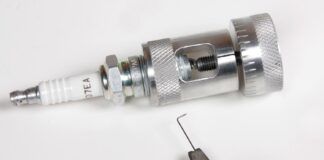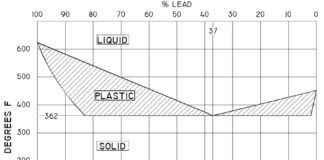Last month, we learned how to construct flat and curved parts from molds. This time, lets see what it takes to build a gas tank out of carbon fiber. In this case, its a 325-gallon tank. Six pounds per gallon (OK, 5.85) multiplied by 325 gallons…thats heavier than the 1320 pounds allowed for an entire Light Sport Aircraft! While this seems like a real out there project, consider that the construction techniques are the same as for a 32-gallon tank. Once you know the basics, its frequently just a matter of scaling up or down the projects that look intimidating.
First off, the materials here were about $3500 for several sheets of two-ply/side carbon fiber with a 3/8-inch honeycomb core-sometimes called a two-core-two, meaning two plies of material then the core and then two more plies. Now aren’t you glad I said it could be scaled down? It sort of reminds me of the guy who said, Ive an unlimited budget and Ive already exceeded it. The advantage to us is that its a lot easier to see whats going on with a project of this size.
The first step is, of course, to have a set of drawings that can be transferred onto the CF using a compass, straight edge, ordinary pencils and a lot of blue painters tape. Don’t use a grease pencil; itll contaminate the surface for later gluing. If its a large (spelled expensive) project, a mock-up in cheaper, easier-to-manage materials is a good idea.
The Value of Carbon Fiber
Thinking through this stack, you’ll realize that the second board was getting compressed less than the top board, and the third board was getting less tension than the bottom board. Now imagine pulling those two middle boards out of the stack while keeping the gap between the top and bottom boards. Youd still have the top board being compressed and the bottom board taking the entire tension load.
This is exactly what CF honeycomb is doing. The paper in between keeps the top and bottom separated so that the bottom takes the entire tension load. This is completely reversible, of course. Top and bottom are just identifiers of the layers; flex the CF in the other direction and it works the same way. From just this example you can see why all modern composite structures are built like this, using some form of a core to separate the load-bearing fiberglass or carbon-fiber layers. Not only is it a strong way to build, it can be made surprisingly light.
Making the Cut
Sanding the edges is also a bit different. Orbital or reciprocating sanders tend to lift the CF away from the paper and fuzz the edges. A hand-size belt sander is the ticket, but position it so that it doesn’t lift the CF.
When it comes to needing a tight fit, Consider a plastic bag; it can be hard to tear you create a tiny notch. That notch is known as a stress riser and serves to direct all the force into a small area, making the tearing pretty easy. Thats why your teeth, though they don’t cut the material, are more eff ective than your soft , round fingers at tearing open a bag of potato chips.
It seems pretty obvious that to eliminate stress risers we have to spread out the load. In this case, that means getting the adhesive epoxy-flox to bothsides of as many surfaces as possible. To do this, simply crush the paper core down about 3/8 inch, exposing the interior sides of the two CF sheets. This operation is surprising the first time you see it simply because going at the CF witha hammer seems anti-tech. As I said, don’t be intimidated by the technology; part of it may be rocket science, but not the part were dealing with.
Once the interior sides of the CF are exposed, we have to add the epoxy-flox, but to ensure adhesion its best to paint the surfaces with straight epoxy. The procedure is referred to as wetting out, and is a simple job of slopping the epoxy into the groove. Again, this is to prevent stress risers in the form of gaps between the CF and the epoxy-flox.
As a quick review, recall that flox is short cotton fiber and is quite strong when mixed with epoxy. Micro, on the other hand, is microscopic glass balloons that are not nearly as strong. They’re great when a lightweight material is needed as a filler in a corner or gap.
Get in the Groove
Youll notice that glass, not CF, is used to radius-out the joints between the flat surfaces. This is because the advantage of CF is negated by not being able to vacuum-bag the junction.
Once the wall is in place and the epoxy-flox has had time to harden, we only have to add a tape of fiberglass to the juncture. We covered that operation in a previous issue, and the procedure is the same here: Radius the corner with epoxy-micro, wet the surface, lay out the tape, smooth out any bubbles, and let it dry. This is getting easy, isn’t it?
The top is the tricky part. Once you’ve laid out the pattern of the walls onto the bottom side of the top and placed a few triangles, you can paint on some epoxy and hope all the parts drop into place.
The Inside Story
By now you’re wondering what a 325-gallon tank fits into. Well, heres a non-clue: Its one of four, and they’re all different shapes. But its a secret project. Well tell you all about it later when the owner gives the go-ahead.
Next month well tackle a smaller project, a set of fiberglass wheel chocks. If you want to build with me Ill be using the materials available in the Composite Materials Practice Kit from Aircraft Spruce, part number 01-15000. (There is also a p/n 01-15100 thats the same kit without the book. I recommend you get the book because your education should never stop and, besides, its worth the extra money just to see photos of a very much younger Burt Rutan.) For this project, you’ll also need a circular razor, a couple of feet of rope, and a plastic or disposable surface about 24×36 inches. The first set I built got appropriated by my wife for her Cessna, so Im making another. Come by and watch them come together.
For more information about AirCrafters builder assistance, call 831/722-9141, or visit www.aircraftersllc.com. A direct link can be found at http://www.kitplanes.com/.




